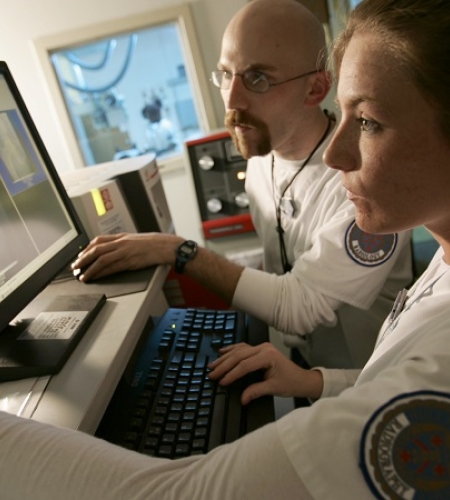
Radiologic Science, ASRS
The Associate of Science in Radiologic Science (ASRS) Degree Program is a 20-month curriculum designed to prepare students for practice in the health specialty of radiography. The degree lays the foundation for future study in the Bachelor of Science in Radiologic Science (BSRS) degree program.
Program Overview
The Radiologic Science Program is a full-time Associate of Science in Radiologic Science (ASRS) professional degree program completed over 20-months. The associate degree is the entry-level degree requirement to be eligible to take the national certification examination in Radiography through the American Registry of Radiologic Technology (ARRT). With the ASRS degree and certification by the ARRT, graduates can work in variety of healthcare settings throughout the United States including hospitals, outpatient centers, physicians’ offices, mobile x-ray companies, research, and industry.
The application deadline for the Radiologic Science Program is December 1st.
Program Details
The program begins once per academic year in the fall semester. Students seeking admission to the program must meet specific program admission requirements that can be found in the “Additional Program Information” below.
Once admitted to the program, students can expect to be on campus for classroom instruction and laboratory practice. Clinical rotations begin in the first semester and experience will experience a minimum of three different sites throughout the duration of the program allowing students to develop clinical skills in a wide variety of healthcare setting that meet the needs of diverse populations.
Additional information can be found using the links below:
- Mission Outcomes
- Program Effectiveness Data
- Additional Program Information
- Accreditation Information
- Clinical Education Handbook
After reviewing these documents, email the Radiologic Science Program at radiologicscienceprogram@holyfamily.edu if you have any additional questions.
Radiologic Technology as a Profession
A Radiologic Technologist (or Radiographer) is a healthcare professional who operates specialized radiographic equipment that uses ionizing radiation to produce images of various body parts. These images created by the Radiographer are then interpreted by a Radiologist, a physician who specializes in analyzing medical images to assist in making a patient diagnosis.
In addition to operating radiographic equipment, Radiologic Technologists provide direct patient care and education, communicate with physicians and other healthcare professionals, prepare and position patients for imaging, evaluate images for quality, and use knowledge and skill to minimize radiation dose to the patient. A successful technologist must also be able to demonstrate compassion, critical thinking skills, and adaptability to changing circumstances.
Career Paths
Students who earn the ASRS degree and certification through the ARRT, have a primary certification in Radiography (x-ray). This is how the majority of people earn their first ARRT credential. There are many opportunities for technologists who have earned a primary credential in Radiography (certified and registered with the ARRT) to pursue an additional credential (post-primary certification) once establishing eligibility by completing ARRT Structured Education and Clinical Education requirements. These include the following:
- Bone Densitometry
- Breast Sonography
- Cardiac Interventional Radiography
- Computed Tomography*
- Magnetic Resonance Imaging*
- Mammography
- Vascular Interventional Radiography*
- Vascular Sonography
- Radiologist Assistant
*Offered at Holy Family University as part of the BSRS degree or as a post-primary certificate option
Program Information
- Degree Awarded
-
- Associate of Science
- Program Type
-
- Major
- Program Location
-
- Main Campus - Northeast Philadelphia
Related Programs
Radiologic Science Post-Primary Certification Tracks UG
Radiologic Technologists with current certification by the American Registry of Radiologic Technologists (ARRT) are eligible to apply for post-primary certification tracks in the following areas: Magnetic Resonance (MR), Computed Tomography (CT), and Vascular Interventional (VI).
Radiologic Science, BSRS UG
The Bachelor of Science in Radiologic Science (BSRS) degree is offered to radiologic technologists certified by the American Registry of Radiologic Technologists (ARRT) or equivalent based on ARRT Supporting Category requirements. The program incorporates the Associate of Science in Radiologic Science (ASRS) degree program.
Health Promotion and Wellness, B.S. UG
The Health Promotion and Wellness program prepares students to assume roles as wellness and health promotion professionals in private business, community organizations, and healthcare agencies.
